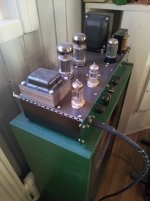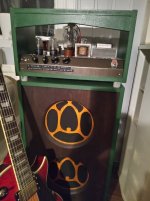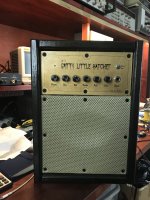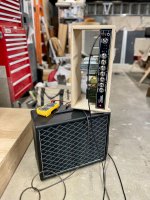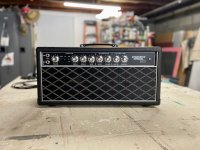O. M. G. You have some some skills. My father is a piano tuner—so, your vid (LOVED) totally spoke to me. FANTASTIC job—well produced video too.
—Have you tried epoxies for your case? Instead of wood glues? For the corner bits etc. Just curious—would increase assembly speeds and you can use various working times for various processes, wood glues of course are quite bulletproof. West Systems have great epoxies—not sure about worldwide avail. There's also a lot of hot glue/super glue formulations.... I love the mini-thickness planer and table saw. This is a ton of work—but you should be absolutely thrilled. I get constant rushes of gratitude from the stuff I've built—endless—even more so becuase they are all music machines. I spent years making books—never knew the screw posts were called "Chicago Rivets". Ha! Are you making the metal bits yourself?
Wasn't sure which amp you might be asking about—I realize there are two in the shot I posted. Bottom, Marshall, is Front Panel Express—they are using digital printing on anodized aluminums. I draw it up/lay it out in Illustrator—they do the work—including drilling holes to my specs—which I then have to replicate in the chassis blank. I haven't found a source for laser etching—the paint fill technique is perfect (but my friend just bought a CAD router setup—can do metal on it too!—not laser—but can do shocking levels of detail). The main amp there I made the panel from scratch—bonded paper backed maple veneer to 1/16" aluminum sheet. Then used a transfer technique to move reversed inkjet printer output to the wood for the various pot labels. Worked really well—the level of detail is surprising—I left it all a bit "hand done" looking in keeping with the Trainwreck aesthetic—the transfer can be controlled with a bone folder and pressure—and one could do color not just black...I played around with various levels of sealing the wood before transfer. Drew the crow—which looks like it has detail due to playing with the transfer pressure...
Again, inspiring work!
—Have you tried epoxies for your case? Instead of wood glues? For the corner bits etc. Just curious—would increase assembly speeds and you can use various working times for various processes, wood glues of course are quite bulletproof. West Systems have great epoxies—not sure about worldwide avail. There's also a lot of hot glue/super glue formulations.... I love the mini-thickness planer and table saw. This is a ton of work—but you should be absolutely thrilled. I get constant rushes of gratitude from the stuff I've built—endless—even more so becuase they are all music machines. I spent years making books—never knew the screw posts were called "Chicago Rivets". Ha! Are you making the metal bits yourself?
Looks great! Are you using laser cutting/etching?
Wasn't sure which amp you might be asking about—I realize there are two in the shot I posted. Bottom, Marshall, is Front Panel Express—they are using digital printing on anodized aluminums. I draw it up/lay it out in Illustrator—they do the work—including drilling holes to my specs—which I then have to replicate in the chassis blank. I haven't found a source for laser etching—the paint fill technique is perfect (but my friend just bought a CAD router setup—can do metal on it too!—not laser—but can do shocking levels of detail). The main amp there I made the panel from scratch—bonded paper backed maple veneer to 1/16" aluminum sheet. Then used a transfer technique to move reversed inkjet printer output to the wood for the various pot labels. Worked really well—the level of detail is surprising—I left it all a bit "hand done" looking in keeping with the Trainwreck aesthetic—the transfer can be controlled with a bone folder and pressure—and one could do color not just black...I played around with various levels of sealing the wood before transfer. Drew the crow—which looks like it has detail due to playing with the transfer pressure...
Again, inspiring work!
A masterpiece of craftsmanship!Looks great! Are you using laser cutting/etching?
I'm making one with more room inside, will have to experiment with which mics sound best...
I play a similar one at the end of this vid:
For a "vibrating air" instrument, piezos won´t do.Looks great! Are you using laser cutting/etching?
I'm making one with more room inside, will have to experiment with which mics sound best...
I play a similar one at the end of this vid:
Best will be some small electret microphone capsule, some intended for cellphones are as small as a grain of wheat.
A masterpiece of craftsmanship!
I'm using wood glues, and I have a ton of tools in miniature - tiny table saw, mini pillar drill, doll size pillar drill, jewellers files 🙂O. M. G. You have some some skills. My father is a piano tuner—so, your vid (LOVED) totally spoke to me. FANTASTIC job—well produced video too.
—Have you tried epoxies for your case? Instead of wood glues? For the corner bits etc. Just curious—would increase assembly speeds and you can use various working times for various processes, wood glues of course are quite bulletproof. West Systems have great epoxies—not sure about worldwide avail. There's also a lot of hot glue/super glue formulations.... I love the mini-thickness planer and table saw. This is a ton of work—but you should be absolutely thrilled. I get constant rushes of gratitude from the stuff I've built—endless—even more so becuase they are all music machines. I spent years making books—never knew the screw posts were called "Chicago Rivets". Ha! Are you making the metal bits yourself?
Wasn't sure which amp you might be asking about—I realize there are two in the shot I posted. Bottom, Marshall, is Front Panel Express—they are using digital printing on anodized aluminums. I draw it up/lay it out in Illustrator—they do the work—including drilling holes to my specs—which I then have to replicate in the chassis blank. I haven't found a source for laser etching—the paint fill technique is perfect (but my friend just bought a CAD router setup—can do metal on it too!—not laser—but can do shocking levels of detail). The main amp there I made the panel from scratch—bonded paper backed maple veneer to 1/16" aluminum sheet. Then used a transfer technique to move reversed inkjet printer output to the wood for the various pot labels. Worked really well—the level of detail is surprising—I left it all a bit "hand done" looking in keeping with the Trainwreck aesthetic—the transfer can be controlled with a bone folder and pressure—and one could do color not just black...I played around with various levels of sealing the wood before transfer. Drew the crow—which looks like it has detail due to playing with the transfer pressure...
Again, inspiring work!
Aha - so its digital printing - is that permanent? Lovely work!
Thanks!A masterpiece of craftsmanship!
So many great projects!!

Thanks!. It's kind of digital? That amp I printed mirrored graphics onto silicone backed paper (like what labels come attached to), and then transferred the images to the wood. Here's the latest‚ this I directly printed onto the veneer after a process of sealing the wood a bit—the veneer is bonded to aluminum sheet to complete the faceplate—though raw wood takes an image just fine and has a certain look to it. The amp pictured isn't complete—awaiting some iron. Yes—permanent—some matte poly sealer—sprayed—once the image is dry—it's not water proof—but it won't easily smudge either. I did get a really nice painterly effect using a brush and water based poly—the inks are water based. I was planning on drawing in by hand some UFOs there in the landscape....👽I'm using wood glues, and I have a ton of tools in miniature - tiny table saw, mini pillar drill, doll size pillar drill, jewellers files 🙂
Aha - so its digital printing - is that permanent? Lovely work!
My low wattage guitar amp. SE 0.15W with a chinese 6j1 pentode as power tube.


Going small. MFOS Noise Toaster with an added PT2399 echo unit. This will go to my grandson. I've done my best to find a suitable box but there ain't much space in there.

This is a small comboI built for a friend. About 9x12" size, with an amp of russian pencil tubes (1JxxB) and a speaker out of an old 60s radio. Sounds not half bad.
The black/blue switch puts the tonestack before or after the main distorion stage. Before is better for blues etc, after better for rock/metal.
These pencil tubes are very microphonic. I had to attach the PCB to a heavy piece of MDF and suspend that in foam.
The black/blue switch puts the tonestack before or after the main distorion stage. Before is better for blues etc, after better for rock/metal.
These pencil tubes are very microphonic. I had to attach the PCB to a heavy piece of MDF and suspend that in foam.
Attachments
Fresh scratch-built Dumble #183 head amp... can see more at the Amp Garage forum where the build thread lives—which seems to be home base for Trainwreck and Dumble builds (no offense DIYAudio, you know I love you)...
This amp is a 100W of NUTS. Built in overdrive and pre amp boost (need to make a foot switch). Sounds absolutely killer no matter what kinda musical styles...really really quiet too—which I found shocking given all that is going on here...There's even a JFet gain circuit on one of the inputs. A super generous guy gave me a care package of a lot of NOS parts based on what was originally used in these amps....hence some vintage-y looking parts. After this Dumble build—This build was like a relaxing breezy day!


This amp is a 100W of NUTS. Built in overdrive and pre amp boost (need to make a foot switch). Sounds absolutely killer no matter what kinda musical styles...really really quiet too—which I found shocking given all that is going on here...There's even a JFet gain circuit on one of the inputs. A super generous guy gave me a care package of a lot of NOS parts based on what was originally used in these amps....hence some vintage-y looking parts. After this Dumble build—This build was like a relaxing breezy day!
Attachments
Love the color knobs! From the "Love my Switches?" online store?Going small. MFOS Noise Toaster with an added PT2399 echo unit. This will go to my grandson. I've done my best to find a suitable box but there ain't much space in there.
View attachment 1080170
maybe he can print this out and and circle each knob on the print-out with the color of the knobs you used, using a pack of color markers. Then get it laminated!
Made in Chian ...Love the color knobs! From the "Love my Switches?" online store?
These people have an entertaining and useful collection of knobs, smaller enclosures, and switches.
A lot of it is guitar stomp box stuff.
https://lovemyswitches.com/knobs/
A lot of it is guitar stomp box stuff.
https://lovemyswitches.com/knobs/
My DIY Analogue Modular.
The Homebrew PCBs, panels and an early panel design:

Final Panel Design, DIY case, DIY low-noise dual-rail Power Supply, DIY Power Distribution, all Euro-rack compatible. The Thomas Henry VCO-555 has a PCB by Fonitronic:

2/3rds filled up, mostly with Yusynth modules, but some Behringer could complete it. This was probably a dry fit test as the VCO-555 is the first module currently.

You may have recognised some of the connectors. The Power Distribution rails come from a copper tube that I opened up, flattened and cut in three.
Just as the Electronic Peasant's builds, a lot of salvaged components found their way in there, including old ATX PSU HDD connectors, PCB capacitors, ATX PSU cables, salvaged large appliance connectors, etc...
The Homebrew PCBs, panels and an early panel design:
Final Panel Design, DIY case, DIY low-noise dual-rail Power Supply, DIY Power Distribution, all Euro-rack compatible. The Thomas Henry VCO-555 has a PCB by Fonitronic:
2/3rds filled up, mostly with Yusynth modules, but some Behringer could complete it. This was probably a dry fit test as the VCO-555 is the first module currently.
You may have recognised some of the connectors. The Power Distribution rails come from a copper tube that I opened up, flattened and cut in three.
Just as the Electronic Peasant's builds, a lot of salvaged components found their way in there, including old ATX PSU HDD connectors, PCB capacitors, ATX PSU cables, salvaged large appliance connectors, etc...
Last edited:
Great idea!The Power Distribution rails come from a copper tube that I opened up, flattened and cut in three.
I have been struggling with how to distribute power in my modular.
And a nice looking synth!

Great idea!
I have been struggling with how to distribute power in my modular.
And a nice looking synth!
Thanks.
If you can find already flat or blocks of copper, it's better than to spend time re-working a tube though 😀
I've got Cu-tape, but I also had ideas of tinned CU-wires with "connection blocks", but so far nothing decided. My rack is nonstandard (7U) and I struggle a lot with the PSU. I have Ray Wilson's wall-wart PSU but just wonder if +/-12V @ 1A is enuff.
I am locking at SMPS modules from Chian (misspeled dilebirately) or have one slightly lager transformer and three smaller PSUs. I have some more modules and plan to redo a few panels.

I am locking at SMPS modules from Chian (misspeled dilebirately) or have one slightly lager transformer and three smaller PSUs. I have some more modules and plan to redo a few panels.
I've got Cu-tape, but I also had ideas of tinned CU-wires with "connection blocks", but so far nothing decided. My rack is nonstandard (7U) and I struggle a lot with the PSU. I have Ray Wilson's wall-wart PSU but just wonder if +/-12V @ 1A is enuff.
I am locking at SMPS modules from Chian (misspeled dilebirately) or have one slightly lager transformer and three smaller PSUs. I have some more modules and plan to redo a few panels.
Hey that's a lot of modules, so very versatile because of how many combinations made possible, well done.
Most of the Linear Regulated PSUs out there are based on Wilson's design. It's an OK design, not an excellent one: layout could be better, noise could be better.
For my distribution, I took some inspiration from Graham Hinton, but there's my own twist on it all.
For Ampere-rating, you'd need to measure the consumption on each rail per individual module and then add them all up, and choose a transformer that can support all of these. This said, 1A - 2A covers a lot I think. Usually, the negative rail consumes less in each module. So instead of one huge transformer, maybe 3 smaller dual-rails PSUs can do the trick better. I am always on the lookout for 12V transformers in thrift stores. You can easily combine two to make a Dual-Rail.
Generally, I'd say avoid the SMPS if you can, but of course, there's a practical aspect to using Large-Transformer Linear Regulated PSUs too.
If you absolutely must use SMPSes, segregate the Digital Modules (even the Digital Oscs, etc...) and power these with the SMPS, then consider an AC-side Filter (can be DIY but be extremely careful here) where you're power distributing AC Mains. For the purely Analogue Modules, avoid the SMPSes like the plague, only Linear Regulated.
This is why I built a separate case for the DIY Analogue Modular, because it has its own very low-noise Linear Regulated PSU. Another case with DIY Digital Modules was planned, and I can power that separately, use my DIY AC Filter box if needed with SMPSes if necessary.
I also decided to adopt the Euro(c)rack format for case and module dimensions as well as Power standard, because it easily allows me to insert any Eurorack module in my setup, provided I use a little DIY power adapter for each since my power connection is the only non-standard item.
Nearly snagged a few Behringer Roland and ARP modules nearby. They're gone now, but there will be more in the future. The used price is probably less costly than DIY and with far better manufacturing quality, so I might go that route for future modules as budget allows.
Last edited:
- Home
- Live Sound
- Instruments and Amps
- Post your DIY Musical Instruments/Amps here!

